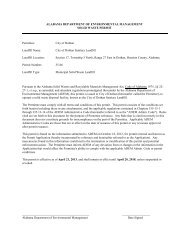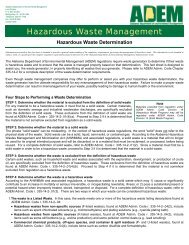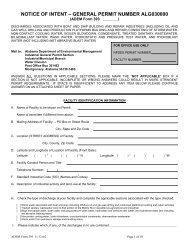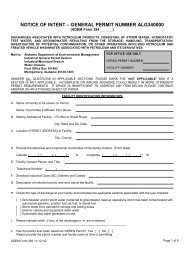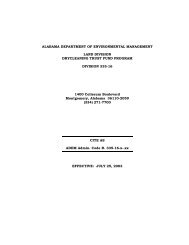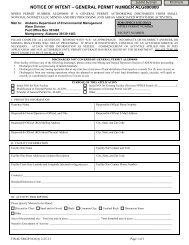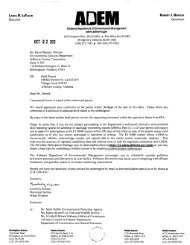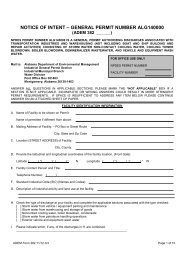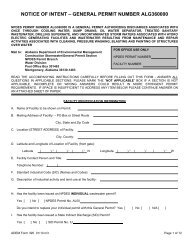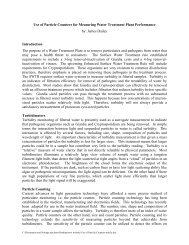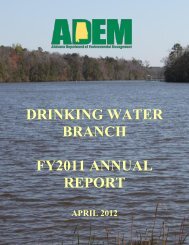NPDES Permit Number AL0025852 - Alabama Department of ...
NPDES Permit Number AL0025852 - Alabama Department of ...
NPDES Permit Number AL0025852 - Alabama Department of ...
Create successful ePaper yourself
Turn your PDF publications into a flip-book with our unique Google optimized e-Paper software.
c.<br />
(3) Design flow <strong>of</strong> treatment facility at time <strong>of</strong> sampling<br />
Source <strong>of</strong> Effluent and Dilution Water<br />
(I) Effluent samples<br />
<strong>NPDES</strong> <strong>Permit</strong> <strong>Number</strong> <strong>AL0025852</strong><br />
Page 28 ono<br />
(a) Sampling point<br />
(b) Sample collection dates and times (to include composite sample start and finish times)<br />
(c) Sample collection method<br />
(d) Physical and chemical data <strong>of</strong> undiluted effluent samples (water temperature, pH, alkalinity, hardness,<br />
specific conductance, total residual chlorine (if applicable), etc.)<br />
(e) Lapsed time from sample collection to delivery<br />
(f) Lapsed time from sample collection to test initiation<br />
(g) Sample temperature when received at the laboratory<br />
(2) Dilution Water<br />
(a) Source<br />
(b) Collection/preparation date(s) and time(s)<br />
(c) Pretreatment (if applicable)<br />
(d) Physical and chemical characteristics (water temperature, pH, alkalinity, hardness, specific conductance,<br />
etc.)<br />
d. Test Conditions<br />
(1) Toxicity test method utilized<br />
(2) End point(s) <strong>of</strong> test<br />
(3) Deviations from referenced method, if any, and reason(s)<br />
(4) Date and time test started<br />
(5) Date and time test terminated<br />
(6) Type and volume <strong>of</strong>test chambers<br />
(7) Volume <strong>of</strong> solution per chamber<br />
(8) <strong>Number</strong> <strong>of</strong> organisms per test chamber<br />
(9) <strong>Number</strong> <strong>of</strong> replicate test chambers per treatment<br />
(10) Test temperature, pH, and dissolved oxygen as recommended by the method (to include ranges)<br />
(II) Specify if aeration was needed<br />
(12) Feeding frequency, amount, and type <strong>of</strong>food<br />
(13) Specify if(and how) pH control measures were implemented<br />
(14) Light intensity (mean)<br />
e. Test Organisms<br />
(I) Scientific name<br />
(2) Li fe stage and age<br />
(3) Source<br />
(4) Disease(s) treatment (if applicable)<br />
f. Quality Assurance<br />
(I) Reference toxicant utilized and source<br />
(2) Date and time <strong>of</strong> most recent chronic reference toxicanttest(s), raw data, and current control chart(s). (The most<br />
recent chronic reference toxicant test shall be conducted within 30 days <strong>of</strong> the routine.)<br />
(3) Dilution water utilized in reference toxicant test<br />
(4) Results <strong>of</strong> reference toxicant testes) (NOEC, IC25, etc.); report concentration-response relationship and evaluate<br />
test sensitivity<br />
(5) Physical and chemical methods utilized<br />
g. Results<br />
(I) Provide raw toxicity data in tabular form, including daily records <strong>of</strong> affected organisms in each concentration<br />
(including controls) and replicate<br />
(2) Provide table <strong>of</strong> endpoints: NOECs, IC25s, PASS/FAIL, etc. (as required in the applicable <strong>NPDES</strong> permit)<br />
(3) Indicate statistical methods used to calculate endpoints<br />
(4) Provide all physical and chemical data required by method<br />
(5) Results <strong>of</strong>test(s) (NOEC, IC25, PASSIFAIL, etc.), report concentration-response relationship (definitive test<br />
only), report percent minimum significant difference (PMSD) calculated for sublethal endpoints determined by<br />
hypothesis testing.<br />
h. Conclusions and Recommendations



